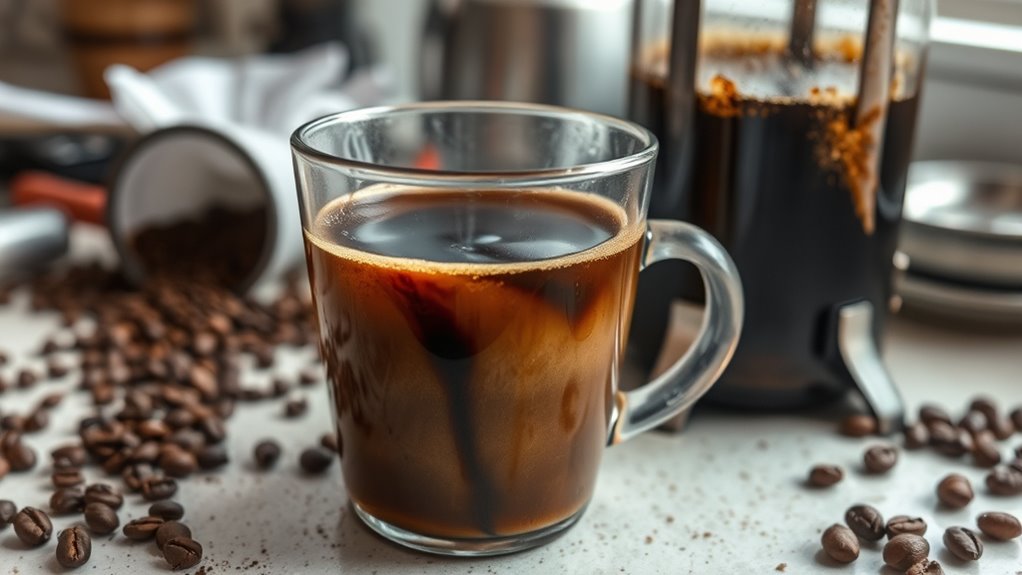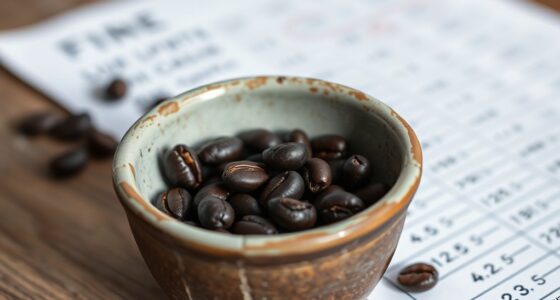Common coffee brewing mistakes happen when you use the wrong water temperature, measure inaccurately, or skip fresh water, which can lead to sour or bitter flavors. Grinding too fine or coarse affects extraction, making your coffee weak or muddy. Poor storage and dirty equipment can dull aromas and introduce off-flavors. If you keep these errors in mind, you’ll brew better cups every time and uncover the science behind perfect coffee in what’s next.
Key Takeaways
- Using incorrect water temperature causes under- or over-extraction, leading to sour, flat, or bitter flavors due to improper solubilization of compounds.
- Inaccurate measurement or inconsistent grind size results in uneven extraction, producing weak, sour, or muddy-tasting coffee.
- Poor water quality and improper storage accelerate oxidation and contamination, diminishing freshness and introducing off-flavors.
- Inadequate cleaning and maintenance build up residues and minerals, causing chemical off-flavors and equipment damage.
- Improper brewing techniques, like rushing or uneven grinding, disrupt extraction balance, compromising flavor clarity and harmony.
Incorrect Water Temperature
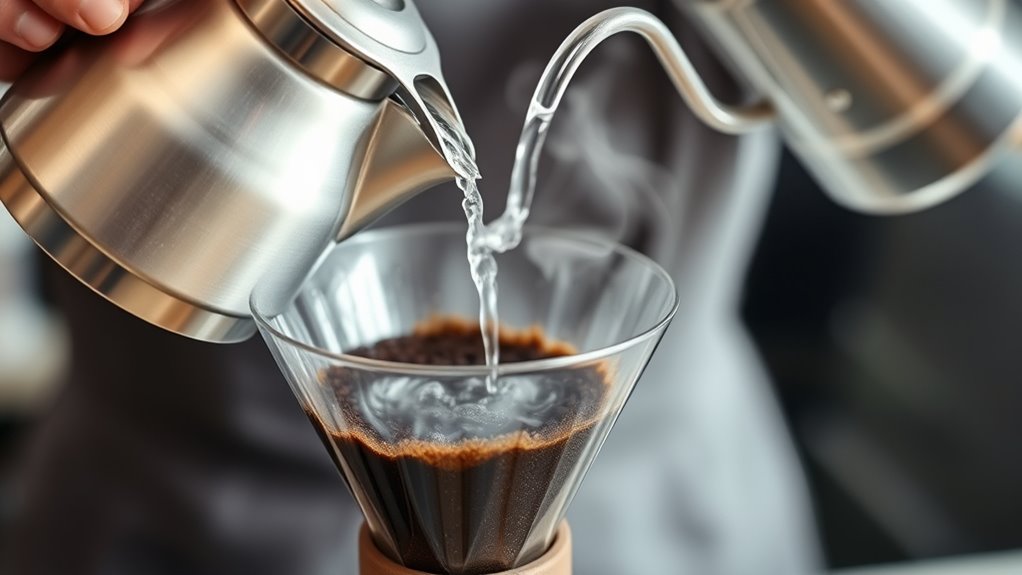
Water temperature plays a crucial role in extracting the best flavors from your coffee. If your water isn’t within the ideal range of 195-205°F (90-96°C), your brew can suffer. Too low, and you’ll get under-extraction, resulting in sour, flat flavors because essential oils and acids don’t dissolve fully. Proper temperature control is essential for achieving optimal extraction. Too high, and over-extraction occurs, causing bitterness and harshness as undesirable compounds are pulled out. Even small deviations of ±5°F can profoundly change flavor chemistry, so precision matters. Using a variable-temperature kettle or properly calibrated brewer helps maintain consistent temps. Remember, boiling water (212°F) often leads to over-extraction unless cooled slightly, so starting with the right temperature ensures your coffee’s flavor profile remains balanced and vibrant. Precision in temperature control ensures that your brewing process consistently highlights the nuanced characteristics of your coffee beans. Additionally, understanding the Science of extraction allows you to fine-tune your technique for the best possible cup. Maintaining precise temperature control is also facilitated by modern shower technology, which can be adapted for precise water delivery in brewing.
Inaccurate Measurements
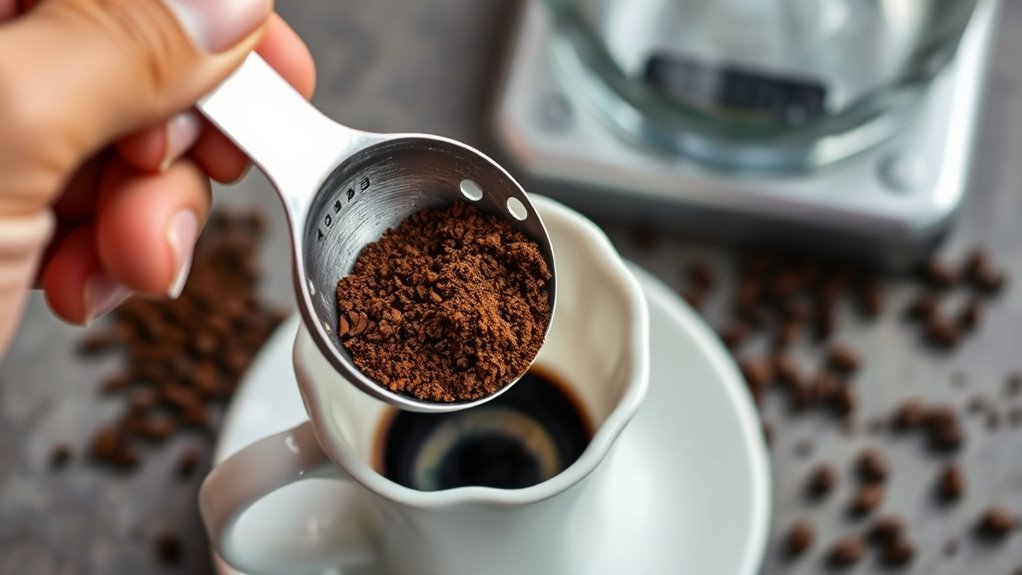
Accurate measurements are the backbone of a good brew. When your coffee-to-water ratio is off, it can lead to under- or over-extraction, resulting in weak or bitter flavors. Using a digital scale guarantees precise measurements, unlike scoops that can vary by ±10-15%. Industry standards recommend ratios between 1:15 and 1:18 (coffee to water by weight) for balanced extraction. Volume measurements are unreliable because roast level and grind size affect density, causing inconsistencies. Overfilling scoops or neglecting to level them introduces additional errors, while different scoop designs can add 2-3 grams of coffee. Properly calibrating your measurements—especially considering roast, grind, and brew method—ensures consistency, flavor accuracy, and a better overall coffee experience. Additionally, understanding the impact of brew temperature on extraction helps optimize flavor profiles and prevents undesirable tastes. Maintaining consistent measurement practices is essential for replicating your ideal brew every time, reducing variability caused by inaccurate measurements. Regularly calibrating your scale and being aware of coffee density variations further enhances precision. Recognizing density fluctuations in coffee beans due to storage conditions can also influence measurement accuracy and extraction quality. Being mindful of measurement techniques can help you develop a more intuitive sense of the right proportions for your preferred brew.
Poor Quality Water
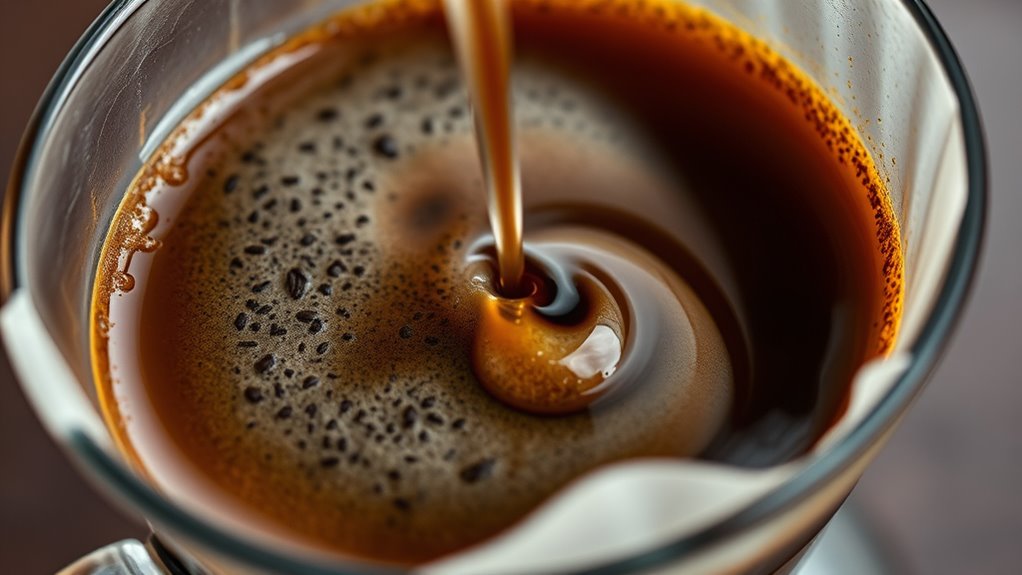
Have you ever considered how the quality of your water influences your coffee’s flavor? Poor quality water can dramatically alter your brew. Hard water, rich in minerals like calcium and magnesium, can enhance flavor but may cause scale buildup and intensify bitterness. Conversely, soft water lacks essential minerals, leading to weak extraction and a flat taste. Chlorine and impurities can introduce chemical or metallic notes, masking natural flavors. An unbalanced pH—too acidic or alkaline—can result in over- or under-extraction, disturbing flavor harmony. Using untreated or poorly filtered water increases the risk of mineral buildup and machine damage, raising maintenance costs. To improve your coffee, always use filtered or purified water with balanced mineral content and a neutral pH, ensuring a clean, flavorful extraction every time. Additionally, selecting appliances with water filtration compatibility can help maintain optimal water quality for brewing. Being aware of water mineral content can also help you fine-tune your brewing process for better results. Incorporating advanced water treatment methods can further optimize water quality and enhance overall coffee flavor. Regularly testing your water’s pH levels can help you maintain the ideal brewing environment.
Insufficient Grinding
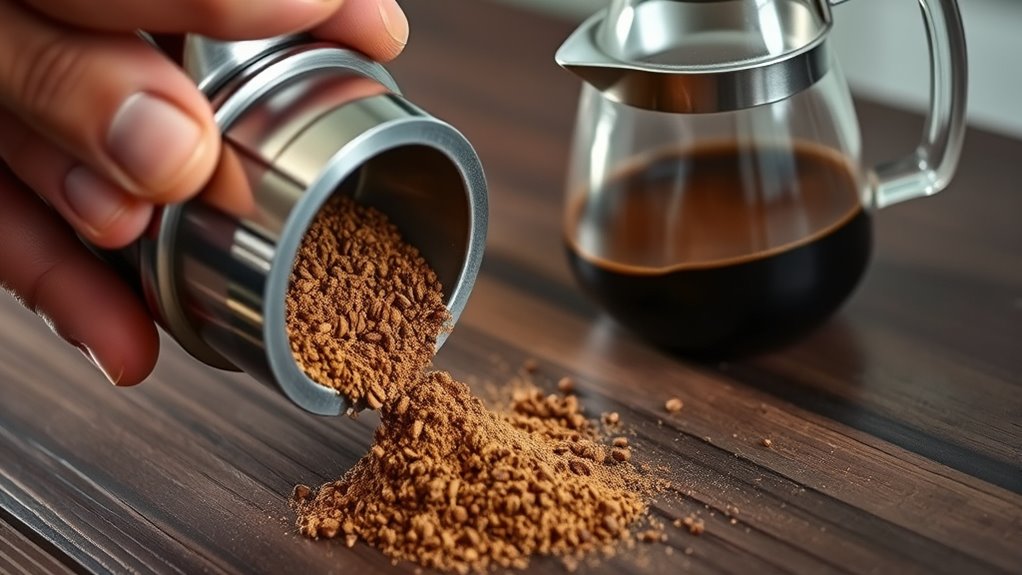
Insufficient grinding can substantially impact your coffee’s flavor and consistency. When your grind size is too coarse, water passes through too quickly, causing under-extraction. This results in weak, sour, or flat flavors because the coffee hasn’t fully released its soluble compounds. Additionally, uneven grind size from inconsistent burr settings or blade grinders creates large particles and fines, leading to unpredictable extraction and muddled taste. Fines can cause over-extraction and bitterness, while boulders result in under-extraction zones. To improve, use a burr grinder for more uniform particles and adjust the grind size according to your brewing method. Properly ground coffee ensures water interacts evenly with grounds, extracting refined flavors and delivering a balanced, satisfying cup. Moreover, cybersecurity vulnerabilities during system outages can affect your coffee equipment’s connected features, so keeping firmware updated is essential for security. Ensuring your grinder operates with consistent performance can help maintain uniform grind size and improve your overall brewing results. Additionally, understanding the Volkswagen Tuning process can help enthusiasts optimize engine performance while avoiding common pitfalls. Staying aware of automation advancements in coffee machines can also enhance your brewing precision and convenience.
Incorrect Coffee Handling
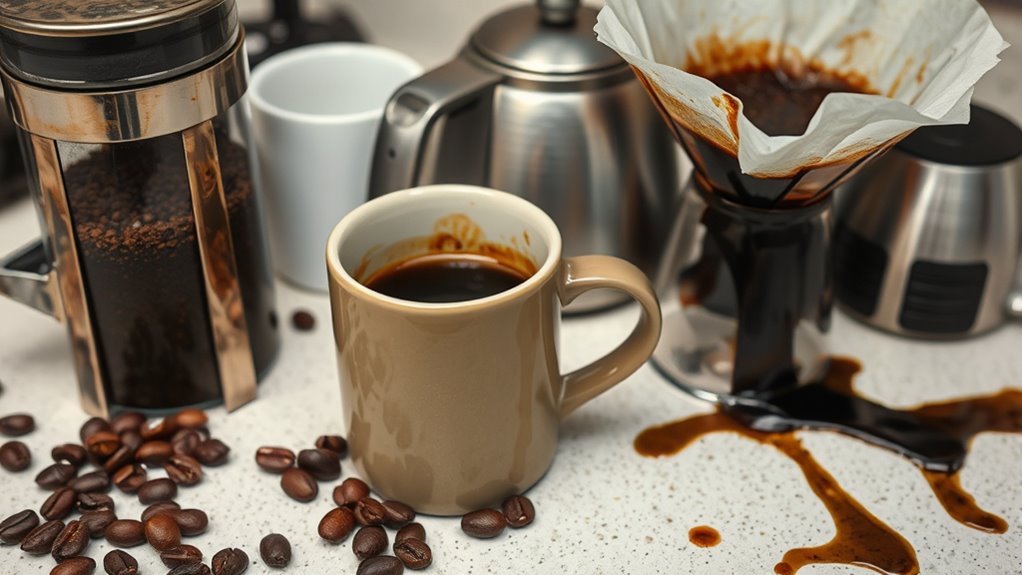
Incorrect handling of coffee can profoundly affect your brew’s flavor and consistency. Using the wrong coffee-to-water ratio, for example, leads to over- or under-extraction. Relying on volume measurements like scoops instead of a digital scale causes inconsistent results, making it hard to replicate your perfect cup. Storing beans improperly—exposing them to light, heat, or moisture—accelerates staling, dulling flavors and aromas. Additionally, mishandling brewing times—pouring too fast or brewing too long—can cause weak or bitter brews. Proper coffee storage ensures your beans stay fresh longer and retain their flavor profile. Maintaining the correct grind size is crucial for optimal extraction and flavor clarity. Water temperature control is equally important, as fluctuating temperatures can lead to inconsistent extraction and flavor distortion. Proper handling ensures your coffee maintains its freshness, balance, and clarity. Using precise measurement tools can greatly improve consistency and taste.
Maintenance and Cleaning Mistakes
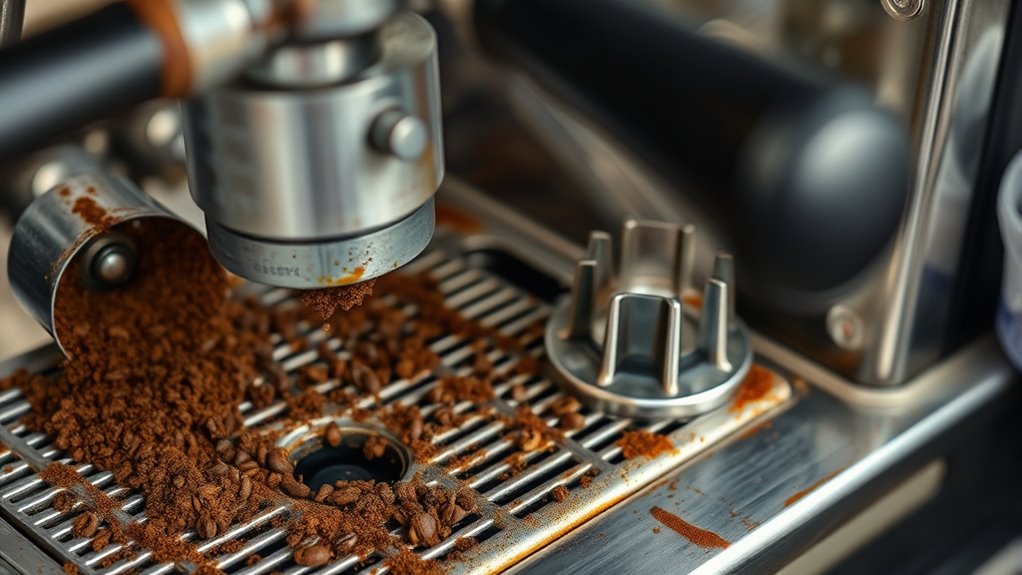
Neglecting proper maintenance and cleaning routines can substantially impact the quality of your coffee. If you wash your coffee maker with detergent too often, soap residue may linger, altering flavors. Scale buildup in the water tank can be managed with vinegar, preventing mineral deposits that affect brewing. Coffee oils can accumulate on brew heads and baskets, requiring regular cleaning to avoid rancid tastes. Using harsh tools like abrasive scrubbers or bleach can damage brewer surfaces or introduce unwanted flavors. Regularly descaling and rinsing with hot water help prevent bacterial growth and mineral buildup. Digital literacy programs encourage proper cleaning techniques and awareness of maintenance routines, which are essential for optimal coffee quality. Skipping routine cleaning of parts like the carafe and filter basket can cause flavor contamination. Incorporating an air purifier in your home can help reduce airborne contaminants that might settle on your equipment, maintaining cleaner air and better-tasting coffee. Ensuring proper equipment maintenance extends the lifespan of your coffee maker and preserves its performance. Proper maintenance also involves understanding headphone compatibility to prevent damage to your device and ensure optimal use. Indoor air quality can influence the overall freshness of your coffee environment, making it an important aspect of maintenance. Consistent cleaning schedules ensure your brewer functions properly and your coffee remains fresh and flavorful.
Using the Wrong Grind Size
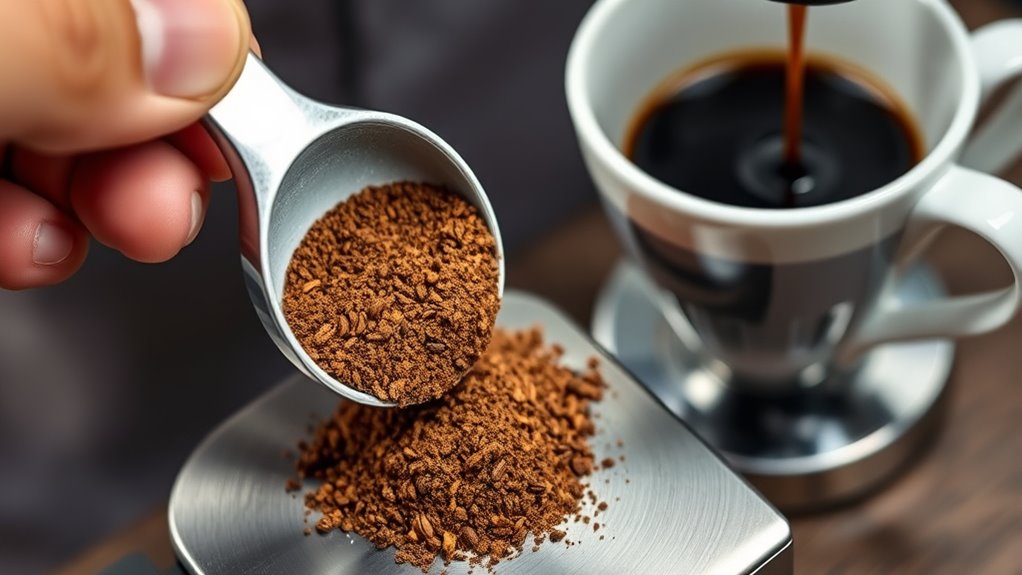
Choosing the right grind size is essential for getting the best flavor from your coffee, especially since different brewing methods demand specific textures. Using the wrong grind can lead to under- or over-extraction, ruining your brew. For espresso, you need a fine grind to build pressure and extract rich flavors in 20-30 seconds; too coarse, and your shot will be weak and sour. French presses require a coarse grind to prevent over-extraction during long steeping. Pour-over methods call for medium grind, with Chemex needing medium-coarse. Moka pots perform best with medium-fine grounds, balancing pressure and extraction. Turkish coffee demands an ultra-fine grind, finer than espresso, to achieve a proper brew. Mismatched grind sizes cause bitter, sour, or muddy flavors, wasting your coffee and ruining your experience. Additionally, using the correct grind size helps prevent clogging or uneven flow in your coffee maker, which can negatively impact flavor extraction.
Neglecting Freshness and Storage
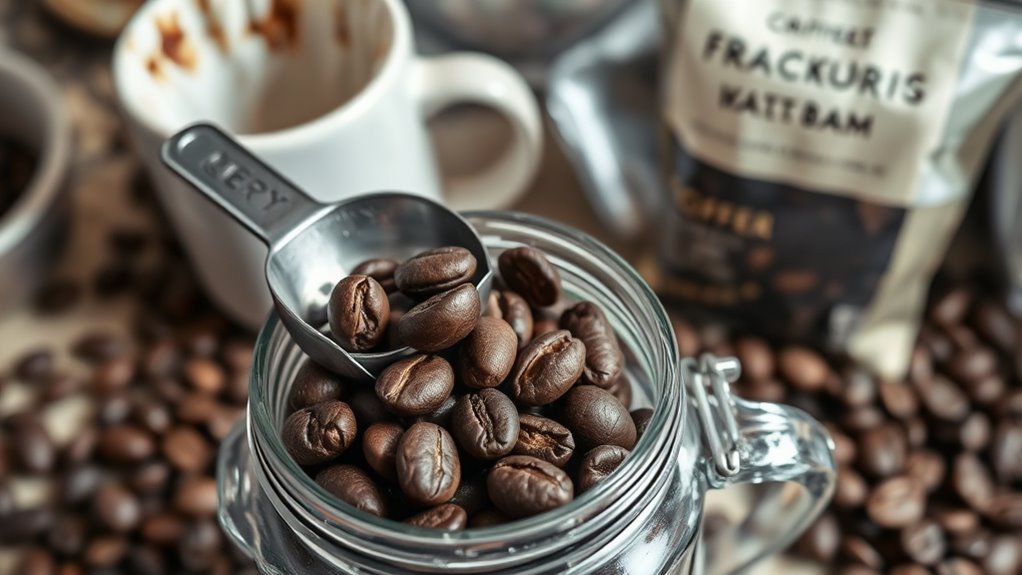
Proper storage is crucial to maintaining your coffee’s freshness and flavor. When exposed to oxygen, light, heat, or moisture, coffee quickly loses its aroma and develops off-flavors. Oxygen causes oxidation, dulling its vibrant notes, while light degrades flavor compounds. Heat accelerates chemical reactions, leading to staleness, and moisture promotes mold growth and flavor deterioration. Temperature fluctuations make oils rancid, diminishing quality. To keep coffee fresh, store whole beans in airtight containers like mason jars or sealed bags, in a cool, dark place. Avoid frequent exposure to light and temperature changes. Consuming coffee within two to three weeks of roasting ensures peak freshness. Proper storage preserves oils and flavors, prevents mold, and helps you enjoy your coffee’s complex aroma and taste every time.
Frequently Asked Questions
How Does Water Mineral Content Affect Coffee Flavor?
Water mineral content directly impacts your coffee’s flavor. When minerals like calcium and magnesium are within ideal ranges, they enhance extraction, bringing out bright, balanced flavors. Too much calcium or magnesium can cause bitterness or dullness, while low levels lead to flat, sour tastes. Chlorides add sweetness, but excess can be cloying. Using properly mineralized water guarantees your coffee tastes vibrant, clean, and well-rounded, highlighting its true character.
Can Inconsistent Grind Size Cause Specific Taste Issues?
Inconsistent grind size can cause specific taste issues in your coffee. You might notice sourness or over-extraction if the grind is too fine, leading to bitterness and a harsh flavor. Conversely, a too-coarse grind can result in under-extraction, making your coffee taste weak or sour. These variations disrupt the balance of flavor, affecting acidity, sweetness, and body, so maintaining a consistent grind size is key to achieving a smooth, flavorful cup.
What’s the Ideal Way to Store Coffee Beans for Freshness?
Think of your coffee beans as precious jewels that need safeguarding. Store them in airtight, opaque containers at room temperature—preferably in a dark, cool cabinet—to shield them from light, air, and heat. Avoid opening the container often, and buy only what you’ll use in a couple of weeks. Keep beans whole until brewing, and never refrigerate or freeze unless properly vacuum-sealed. This way, your coffee stays vibrant and fresh.
How Often Should I Clean My Coffee Equipment for Optimal Taste?
You should clean your coffee equipment regularly to guarantee the best flavor. Rinse post-brew immediately to prevent oil buildup, wash removable parts weekly, and do a quick group head flush after each shot. Deep-clean the portafilter, backflush the machine, and sanitize water tanks weekly. Descale every 2-3 months if you have medium-hard water, or more often if your machine is heavily used, to keep your coffee tasting fresh and equipment functioning smoothly.
Does Brewing Time Influence Extraction and Bitterness?
Brewing time directly affects how much coffee solubles get extracted, influencing flavor and bitterness. If you brew too long, over-extraction occurs, leading to bitter, dull tastes. Shorter times can under-extract, resulting in sourness. By adjusting your brewing duration based on your method and preferences, you control extraction levels. Keep an eye on timing, and you’ll balance flavor and minimize bitterness for a better cup every time.
Conclusion
By avoiding these common mistakes, you’ll transform your coffee routine into a rich, aromatic experience. Picture steaming cups filled with perfectly brewed liquid gold, each sip bursting with flavor. When you pay attention to water temperature, grind size, and freshness, you reveal the true potential of your beans. So, take control, fine-tune your process, and savor every cup like it’s a morning masterpiece waiting to be enjoyed. Your perfect brew is just a few mindful steps away.
